3.6 /10 2 Votes
5/10 TV First episode date 16 January 1998 | 7.3/10 IMDb Also known as Robot Wars Extreme Directed by Stuart McDonald | |||||||||||||||||||||||||||||||||
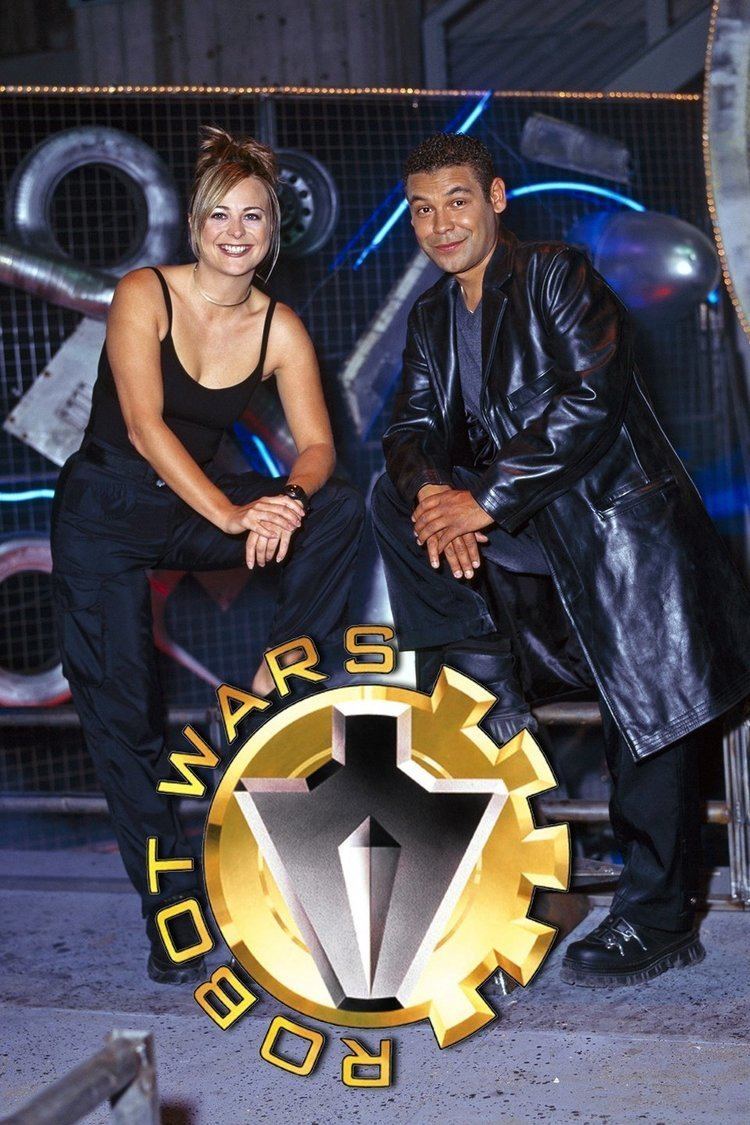 | ||||||||||||||||||||||||||||||||||
Created by Tom GutteridgeSteve Carsey Voices of Stuart McDonald (1998-2003) Presented by Nominations British Academy Television Award for Best Entertainment Programme Similar Profiles | ||||||||||||||||||||||||||||||||||
Robot wars episode 2 battle recaps bbc two
Robot Wars is a British robot competition that was first broadcast on BBC Two from 20 February 1998 to 23 February 2001, on BBC Choice from 8 October 2001 to 7 February 2003 (later repeated on BBC Two), on Channel 5 from 2 November 2003 to 28 March 2004 before being revived in 2016 and broadcast on BBC Two from 24 July 2016. A celebrity special was shown on BBC One on 27 December 2000. The show was originally presented by Jeremy Clarkson for the first series before Craig Charles took over until the seventh series. Philippa Forrester co-hosted the first three series, the fifth and Extreme 2. The fourth series and Extreme 1 were co-hosted by Julia Reed and the seventh by Jayne Middlemiss. Jonathan Pearce provided commentary for all series. The new presenters for 2016 are Dara Ó Briain and Angela Scanlon.
Contents
- Robot wars episode 2 battle recaps bbc two
- Robot wars grand finale 2016 battle recaps bbc two
- US Robot Wars events
- Original television series
- Revival
- Battle rules
- Extreme
- Presenters
- House robots
- Arenas
- Hazards
- Competitors and results
- Toys
- Home media
- Video games
- Other
- Transmissions
- Extreme series
- US Robot Wars
- Nickelodeon Robot Wars
- References
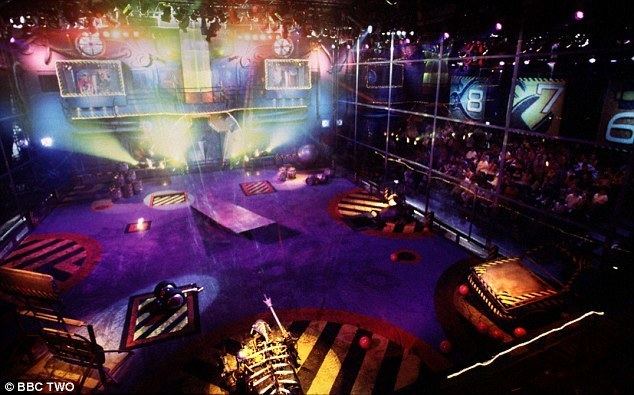
Additional series were filmed for specific sectors of the global market, including two series of Robot Wars Extreme Warriors with American competitors for the TNN network (hosted by Mick Foley with Rebecca Grant serving as pit reporter), two of Dutch Robot Wars for distribution in the Netherlands, and a single series for Germany. The fourth series of the UK Robot Wars was shown in the US on TNN as Robot Wars: Grand Champions in 2002, and hosted by Joanie Laurer.

The series, centred on the sport of robot combat, involved teams of amateur and professional roboteers operating their own constructed robots to fight against each other in both friendly and tournament matches, whilst also avoiding arena hazards and more powerful "House Robots", which were not bound by the same weight or weapon limits as the contestants. Earlier series included assault and trial courses for competing robots before they were ceased from the first "Extreme" series onwards.
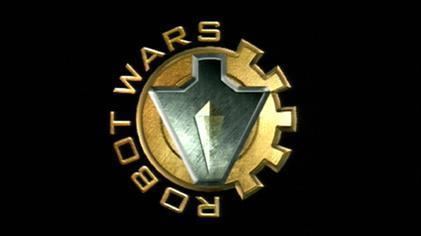
Its merchandising was commercially successful, being one of the most popular selling toy ranges in 2002. It included a mini arena, pullback toys and radio-controlled versions of Shunt, Matilda and Sir Killalot.

In 2003, the roboteers themselves formed The Fighting Robot Association and with their associated event organizers, carry on participating in competitions for new audiences. In 2013, Roaming Robots purchased the rights to the Robot Wars brand from Robot Wars LLC and now operates their travelling robotic combat show under that name. The use of the name Robot Wars ceased in early 2017, with the shows being renamed Extreme Robots.
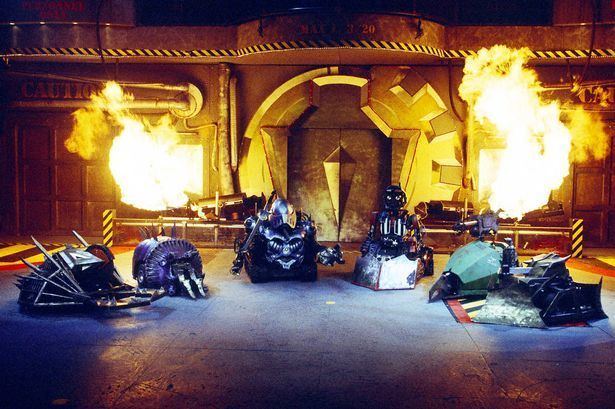
With a peak audience of 6 million viewers in the UK during the late 1990s, the format went on to become a worldwide success, showing in 45 countries including the US, Australia, Canada, China, India, Germany and Italy. In March 2003, it was dropped by BBC Two after eight series and Mentorn announced it was making 22 episodes for Channel 5, concluding with the third World Championships broadcast in March 2004. Channel 5 later axed the show after one series due to low ratings.
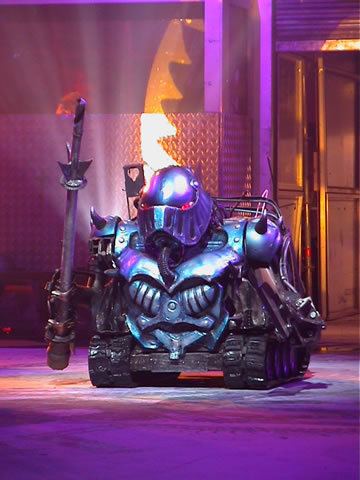
In July 2016 the show returned to BBC Two with a new arena, house robots and presenters. The first episode was well received becoming the top trending topic on Twitter that evening and having 2 million viewers, more than the last episode of the 23rd series of Top Gear in the same 8pm Sunday slot just a few weeks earlier. After the success of the relaunch, 6 more episodes are set to air in 2017.
Robot wars grand finale 2016 battle recaps bbc two
US Robot Wars events
Robot Wars was the brainchild of Marc Thorpe, a designer working for the LucasToys division of Lucasfilm. In 1992, Thorpe had the initial idea for robot combat sport after unsuccessfully attempting to create a radio-controlled vacuum cleaner. In 1994, Marc Thorpe created Robot Wars and held the first competition at the Fort Mason Center in San Francisco. Approximately one month prior to the event, Thorpe formed a partnership with New York-based record company Sm:)e Communications, later Profile Records, who provided additional funding.
Between 1995 and 1997, three further Robot Wars events took place in America and, in 1995, Profile Records partnered with production company Mentorn to produce and televise a Robot Wars event in the UK. Mentorn acquired the worldwide television rights from Profile in 1995 after Tom Gutteridge (the head of Mentorn) had seen an amateur tape of a San Francisco event.
Original television series
Gutteridge and one of his producers Steve Carsey created a television format based on the Robot Wars concept. They produced a live event opposite BBC Television Centre in Wood Lane, Shepherd's Bush, London and hired Derek Foxwell to build 3 combat robots, 2 of which were named The Mouse and Grunt who would eventually take part in the first UK series of Robot Wars, to take on three American robots, Thor, La Machine and The Master, all of which were veterans of the original American competition. The Controller of BBC Two, Michael Jackson, attended the event, which was not filmed, and he promised to commission a series. However, it wasn't until 1998 that a subsequent Controller of BBC Two, Mark Thompson, fulfilled Jackson's promise and actually commissioned 6 episodes. Gutteridge and Carsey were producers and Foxwell was the technical supervisor and senior technical consultant. He drafted the rules and regulations and was in charge of the pit area and the technical team, which scrutineered the robots, got them on and off stage and helped the contestants prepare and repair their robots. Mat Irvine, initially a member of the technical team, served as member of the judging panel in 2002 and 2003.
The three person judging panel consisted of Noel Sharkey (head judge on every series: 1998–2003, 2016–), Eric Dickinson (1998), Adam Harper (1998–99), Martin Smith (1999–2003), Myra Wilson (2000–01), Mat Irvine (2001–03), Sethu Vijayakumar (2016–) and Lucy Rogers (2016–).
On the first day, I was in the dressing room and looking in the mirror, and looking down at the arena. And they were pulling the robots into the arena on an invisible twine because nothing was working. And I was thinking: "Oh my God, what have I done with my career?" And you know, within the blink of an eye, it was the most watched show on BBC2.
Profile sought no input or consent from Thorpe before doing this, and this aggravated the already troubled relationship between Thorpe and Profile Records and indirectly spurred legal disagreements surrounding the ownership of the Robot Wars concept. The legal proceedings surrounding these would last until 6 February 2002. Mentorn used Thorpe as a Consultant on the series, however, and the initial series of Robot Wars in the UK was broadcast over six weeks in February and March 1998. It was an immediate hit, with more than 2 million viewers, and a further 18 episodes were commissioned by the BBC that year. 155 episodes were produced in total, and the show was seen in 26 countries. Two series were produced in the US for the TNN (now Spike) network, and a version was also shown on Nickelodeon. Series were also produced in many European countries. Although the series had various directors and producers, all were produced in the UK by Mentorn, and executive produced by Tom Gutteridge and Steve Carsey. The initial series were staged in various film studios around London but the stage and pit area became too large to fit into any of the conventional studios, so filming was later moved to an aircraft hangar at RAF Newton.
Viewing figures dropped significantly in the early 2000s, reaching only 1.2 million in the sixth series - the final to be broadcast on BBC Two. Following its move to Channel 5 in November 2003, the show first began airing in a new Sunday night slot and launched with 1 million viewers; however ratings fell quickly to 800,000 resulting in the show moving to Saturday nights after just three episodes.
Revival
On 13 January 2016, the BBC confirmed that it would be rebooting the show for a six-part series. On 3 February 2016, BBC Press Office confirmed via Twitter that Dara Ó Briain would host the new series, with Angela Scanlon serving as pit reporter and Jonathan Pearce returning as commentator. In early July 2016, following the release of several "coming soon" trailers on air and online, it was announced it will return on 24 July at 8pm, the same slot as Top Gear. Some robots from the original series returned, including Storm II, Razer and Behemoth, as well as four of the original House Robots, which have been upgraded to be heavier, faster, better armed and with new looks. The 2016 series was filmed in a warehouse at Westway Park in Renfrew, Scotland.
The first episode received about 2 million viewers and was the top trending topic on Twitter with over 20,000 tweets.
A second rebooted series was commissioned with a first celebrity special in 16 years, in which celebrities, such as Olympians Kadeena Cox and Alistar & Jonathan Brownlee, TV Presenters Suzi Perry, Neil Oliver, and Maggie Aderin-Pocock, singer Jordan Stevens, and radio presenters Scott Mills and Robbie Savage had bespoke robots designed for them by 8 major roboteers, who mentored them during the specials.
During its original airing, the first rebooted series was sometimes referred to as 'Series 1', presenting itself as a completely new show. Starting in 2017, however, the BBC began referring to it as Series 8, with the upcoming second series appropriately dubbed Series 9, acknowledging itself as a continuation of the original show.
Battle rules
A robot could lose a match in several ways during the knockout format of the show:
Although the format changed several times over the years, these rules remained the same across all series and competitions.
Extreme
There were also two series made for the UK, Robot Wars Extreme, which did not focus on a single championship.
Presenters
The first series of Robot Wars was presented by Jeremy Clarkson and co-hosted by Philippa Forrester. In keeping with his edgy persona established on Top Gear, Clarkson frequently made tongue-in-cheek jokes about competitors and their robots, such as remarking that a contestant robot called "Skarab" looked like "cheese on toast".
Clarkson left Robot Wars after the first series and was replaced with Craig Charles. Charles, well known as playing the character Dave Lister in the science fiction-themed sitcom Red Dwarf, was seen as taking the programme and its contestants more seriously than Clarkson, and was more enthusiastic while presenting it. Charles would close each episode with a four line poem ending with the words "Robot Wars". Charles presented Robot Wars until it ceased production in 2004.
"My son, Jack, was a fan of the first series and said I should get involved. So I made a few phone calls and the rest is history."
In comparison to Charles' background in science fiction, Philippa Forrester was best known as co-host of the science and technology programme Tomorrow's World. Her role on Robot Wars was as the pit reporter who would speak to contestants about their robots before and after battles. Forrester was pit reporter for six of the show's nine series; Julia Reed took the role for Series 4 and Extreme 1 since Forrester was unable to participate in the programme due to pregnancy, but Forrester returned for Series 5, Series 6 and Extreme 2. When the programme moved to Channel 5 for the seventh series, Forrester did not return for unknown reasons, so Jayne Middlemiss took over the pit reporter duties.
Jonathan Pearce was the show's commentator throughout its entire run. He commentated in the same loud and enthusiastic manner as his football commentaries. The programme was well known for phrases such as "Roboteers, stand by", "3. 2. 1. Activate" and "Cease!". These phrases were announced by the director, Stuart McDonald and became a recognisable part of the series for the entire duration of its run.
In 2016, Dara Ó Briain and Angela Scanlon were announced as the hosts of the eighth series, with Jonathan Pearce returning as commentator. They reprised their roles in the ninth series, which has since been broadcast and is still ongoing.
House robots
Throughout the series, house robots acted as obstacles to competing robots in battles and challenges. House robots were permitted to attack robots that were in the Corner Patrol Zones at the corners of the arena or upon the submission of a competing robot. The house robots were an intrinsic part of the programme's success and merchandising of these robots was highly successful. Furthermore, the house robots were not subject to the 100 kg (220 lb) weight limit or weapon rules that contestant robots had to adhere to, the most notable example of this was Sergeant Bash's flamethrower.
From the Fourth Wars, a non-competitive "Refbot" was present during fights. This robot conveyed officiating signals (such as counting out immobile competitors) on the arena, gave occasional nudges to help battles along, and could deploy a fire extinguisher where necessary.
For Series 8, new versions of Matilda, Shunt, Dead Metal, and Sir Killalot have been constructed. They are considerably heavier with improved weaponry. All the house robots are over 300 kg (661 lb) in weight, and Sir Killalot now weighs 741 kg (1,634 lb). Visually, all four look similar to their predecessors, but with significant differences: Dead Metal's head has been enlarged with glowing eyes, Matilda's back-mounted fins have been replaced with smaller crocodilian scales, spikes appear on her frill, her eyes are now red and her whole head section now flips up; Shunt has enlarged wheel protectors and metal chimneys replacing the smokestack; and Sir Killalot's armour and helmet has been entirely redesigned. The other house robots did not return for this series.
Bold text indicates house robots that returned for the new series.
Note: The house robots returning now have new statistics
Arenas
There were numerous arena incarnations used during the original run of Robot Wars on the BBC. These arenas were also used by international versions such as Robot Wars: Extreme Warriors in the United States. The arena was approximately 32 by 48 feet (9.8 by 14.6 m). For Series 1 to 3 the arena was not enclosed as such, as the audience were raised above the arena. The increasing sophistication of weaponry from contestant robots - most notably demonstrated by Hypno-Disc in Series 3 - as well as arena hazards prompted producers to enclose the arena entirely in a perspex box 20 feet (6.1 m) high from Series 4 onwards, to protect the audience and production team from debris.
Although the perspex screen mullions and transoms impaired the live audiences' view as well as external views of the arena on television, on numerous occasions it proved to be necessary. The floor flipper would send lighter robots (such as featherweights) out of the arena and straight into the perspex box. Furthermore, items from the drop zone were often unpredictable, most notably when Matilda obliterated a television screen with her flywheel sending shards of glass strewn across the arena.
In early 2004, the Robot Wars arena was purchased from the television production firm Mentorn by a company called Robot Arenas Ltd., based in the UK, an organization set up by a past competitor in Robot Wars to continue the sport of robot combat in the UK. The arena - valued originally at £11,000 - was sold for scrap in 2005 for £250 by the new owners of the former RAF Newton air base, where the arena was housed. A suit filed against RAF Newton by Robot Arenas Ltd. found that RAF Newton had acted reasonably in the matter and owed no compensation to Robot Arenas Ltd.
In 2016, a new arena was constructed in a warehouse in Renfrew, on the outskirts of Glasgow, for use in the rebooted series. This arena is 15 metres (49 ft) square, with a 6 mm (0.24 in) steel floor and higher bulletproof walls, making it harder for robots to be thrown out of the arena.
Hazards
Throughout Robot Wars' run, arena hazards were introduced and amended. Generally, hazards which proved ineffective were omitted in later series, however some hazards proved to be a success (such as the Pit of Oblivion, Floor Flipper, and the Drop Zone) and were retained. The assorted hazards in the arena that changed from one series the next included:
Competitors and results
The competing robots are listed in Category:Robot Wars competitors.
Toys
Pullback and friction toys were made of all the House Robots, with the exception of Cassius Chrome as the toys had stopped production when he was introduced for The Seventh Wars. There were also pullback and ripcord toys of Chaos 2, Dantomkia, Firestorm, Hypno-Disc, Panic Attack, Pussycat, Razer, Stinger, Tornado, Wheely Big Cheese and X-Terminator 2. Each came with an accessory.
There were remote controlled versions of Shunt, Matilda, Sir Killalot, and Growler. There also were smaller remote control battlers, which had "immobilisation spots" on the rear of the toy. Sgt. Bash, and the competitor robot Tornado were the only two made. These were smaller than the other remote control robots mentioned above.
There were customisable kit toys of the House Robot Matilda, and competitors Hypno-Disc and Panic Attack. A Sergeant Bash pitstop kit was prototyped but never released.
Minibots were a series of small die-cast replica robots. The range included all of the Series 5 House Robots along with competitor robots Chaos 2, Dominator 2, Firestorm III, Gemini, Hypno-Disc, Mega Morg, Panic Attack, Plunderbird 5, Pussycat, Razer, Suicidal Tendencies, Tornado, Wheely Big Cheese, Wild Thing and X-Terminator 2. They had an interactive replica arena and two additional playsets.
Home media
Several VHS videos were released of the show. These included "The First Great War" a look at the making of Series 1, "The First World Championship" which was released exclusively on video at the time and the "Ultimate Warrior Collection" featuring exclusive access to the teams of Chaos 2, Hypno-Disc and Razer, along with footage of their battles. Along the same lines a "Ultimate Archive Collection" was released showing exclusive footage of the House Robots and their operators along with some of their greatest battles and most embarrassing moments.
The Ultimate Warrior Collection, Ultimate Archive Collection and First Great War were also released on DVD. The footage and content remained the same as the VHS releases. The 2016 series was released on DVD on 29 August 2016, making it the first full series of Robot Wars to be released on home media.
The 2016 series of Robot Wars was released on DVD and digitally.
Video games
Robot Wars: Metal Mayhem is the first game based on the show, released on Game Boy Color in 2000. It was followed in 2001 by Robot Wars: Arenas of Destruction on PlayStation 2 and Microsoft Windows and Robot Wars: Advanced Destruction on Game Boy Advance. After the first three titles sold over 250,000 copies, a fourth and final game, released on Game Boy Advance, Microsoft Windows and Xbox in 2002 was called Robot Wars: Extreme Destruction.
Other
A huge array of other merchandise was produced due to the success of the show. Items available included mugs, glasses, mobile phone covers, toiletries, stationery, clocks, watches, bedding, curtains and clothing. The show even produced an unsuccessful single, which peaked at number 51 in the UK singles charts in December 2000, called "Sir Killalot Vs. Robo Babe - Robot Wars (Android Love)". A custom made game officially licensed under Robot Wars LLC was started on in October 2013, using the Robot Arena 2 video game as the base. It featured many robots from the TV series as well as robots competing in the newer live events, also including the original Robot Wars arena and various live arenas. It was released to the public in September 2015 and an updated version which included more robots was released in February 2016. A one-time update was released in January 2017, adding 2 new robots. It is only available for Microsoft Windows.
Transmissions
All episodes were announced by Jonathan Pearce.
Extreme series
All Extreme episodes premiered on BBC Choice.
US Robot Wars
A forerunner to the UK series, the 1994 Robot Wars in San Francisco, California featured three different 'games' for each of three robot weight classes:
The FACE-OFF paired robots to battle through an elimination tournament. A robot won a match by immobilizing its opponent, either by damage or by pinning. If both robots were still mobile at the end of ten minutes, they both advanced to the next round of the tournament.
The MOB SCENE was a free-for-all melee fight amongst multiple robots. There were two Mob Scene fights: one for lightweight robots, and a never-repeated 'all weight classes' melee.
The ESCORT event had a single competitor robot escort a defenseless "drone" robot across the arena while a "house robot" attempted to attack the drone. The successful escort with the lowest time was declared the winner. The Escort event was contested only in 1994.
Weight classes for the first event were:
Lightweight: 10 to 40 pounds (4.5 to 18.1 kg)
Middleweight: 41 to 70 pounds (18.6 to 31.8 kg)
Heavyweight: 71 to 100 pounds (32.2 to 45.4 kg)
Superheavyweight 101 to 170 pounds (45.8 to 77.1 kg)
The competition format remained much the same through 1997. Additional safety regulations were implemented each year, match length was trimmed to 5 minutes, a 'featherweight' weight class was added, and weight allowances crept upward; by 1997 the heavyweight maximum was 170 pounds (77 kg).
The 1997 judging criteria removed pinning an opponent for 30 seconds as an automatic win and required such immobilization techniques to be limited to one minute. The 1997 judging criteria also removed 'audience applause' for selection of a winner when a match ended with both robots still mobile. Robots were judged by a panel based upon a point system that took into account three factors: damage, aggression, and control. Of these three factors, damage was the primary criteria for determining a winner.
Nickelodeon Robot Wars
In 2002, the American television network Nickelodeon created Nickelodeon Robot Wars, in which children operated combat robots provided by American teams.
